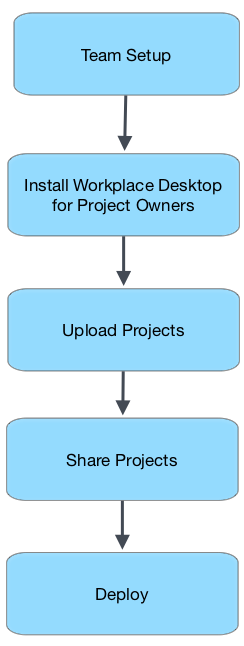NOTE The information in this toic is intended for Workplace administrators tasked with setting up and managing a Workplace implementation.
NOTE Please be sure to fully review our Getting started: Projects and Getting started: Implementation topics before proceeding with this supplementary guide.
This guide should be followed if the current data set is scattered across multiple users’ local storage devices and all this data is to be moved to the Workplace service:
Create users
This is usually the best time to create users. If you are using groups effectively, you can add the users at a later time and add them to the appropriate groups, which in turn will assign the policy profiles applied to the groups they are added to and grant access to the projects shared with those groups.
Create users according to the instructions in one of the following topics:
- Add a user
- Active Directory integration guide, if the Active Directory integration is enabled.
TIP To learn how to add multiple users at once, refer to Import users.
TIP Users can be created as copy of another user, reducing the time to configure each user. Refer to Create new users by copying an existing user.
For information about the different user types and what they can see and do in Workplace, refer to User types.
After users have been added, they will receive an email with instructions on how to activate their accounts (unless the Suppress Welcome Emails policy is enabled).
TIP Account activation links automatically expire after one week. If necessary, you may always resend the welcome email to a user from the User details page, or from the right-click menu on the Users page.
Create groups
Create Groups to make sharing and administration of the team easier!
Create and assign policy profiles
Now that the users and groups are created, proceed to create and assign Policy Profiles.
Project owners should download and install the Workplace app . Refer to Install or uninstall the Workplace app.
NOTE This step assumes the data has already been structured as outlined in Getting started: Projects
To upload data, simply have the users drag and drop the folders that are to become projects into their Workplace folder.
Wait for the key projects to fully upload before continuing. Less critical projects can be uploaded and shared with other users in conjunction with subsequent steps, or at any time. If you are uploading the key projects first, continue with the remaining steps after the upload of these key projects is complete then repeat steps 3, 5 and 6 for the subsequent projects.
Be aware it may take a long time to upload the projects, dependent on size and file count. As each file needs to be linked with its counterpart on the Workplace service, there is an overhead for each file. The effect of this is that a large amount of small files may have a small total file count, but may still take a long time to sync as it performs the necessary actions on each file. Taking this into consideration, it would be expected for a 5GB Project containing five files to upload much faster than a 1GB Project with 50,000 files.
Create users according to the instructions in one of the following topics:
- Add a user
- Active Directory integration guide, if the Active Directory integration is enabled.
TIP To learn how to add multiple users at once, refer to Import users.
TIP Users can be created as copy of another user, reducing the time to configure each user. Refer to Create new users by copying an existing user.
For information about the different user types and what they can can see and do in Workplace, refer to User types.
After users have been added, they will receive an email with instructions on how to activate their accounts.
Install the Workplace app on the machines of these new users, as described in step 2. Alternatively, you may wish to perform a Silent installation, which can be used in conjunction with the Deployment feature to silently configure the Workplace app.
Once all the users have installed the Workplace app, the projects and folders these users need to access should be shared with them. You'll use team shares to do that.
Find out more about sharing projects in Manage project, folder, and file team shares.
Each teams needs will be unique and user education should be focused on the features most needed by the team.
We strongly recommend all users that will own projects review the Getting started: Projects guide.
IMPORTANT Users who are new to cloud syncing services may not understand that if they delete folders or files locally, those files or folders will be deleted from Workplace and, subsequently, from all other users with whom the deleted data was shared. While this should be minimized with effective use of the permissions, we recommend that you ensure that users are familiar with this concept.




